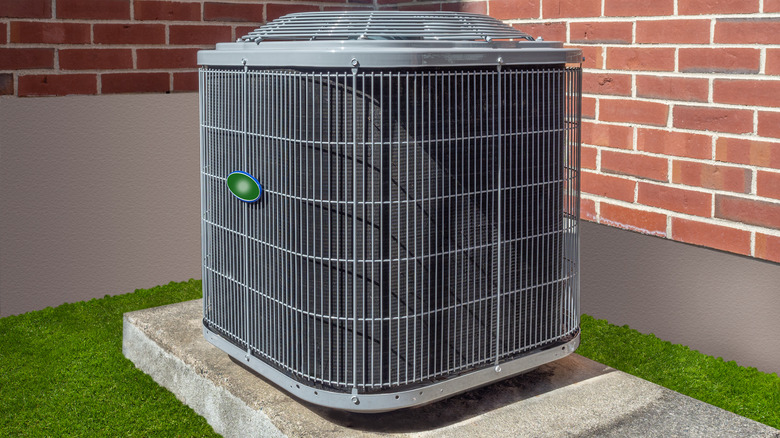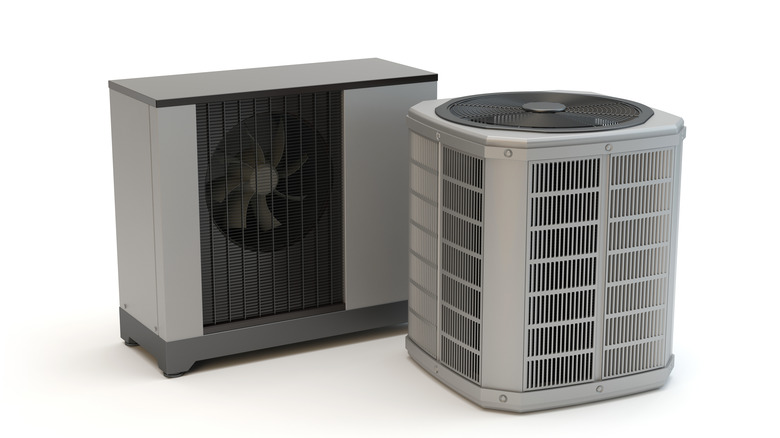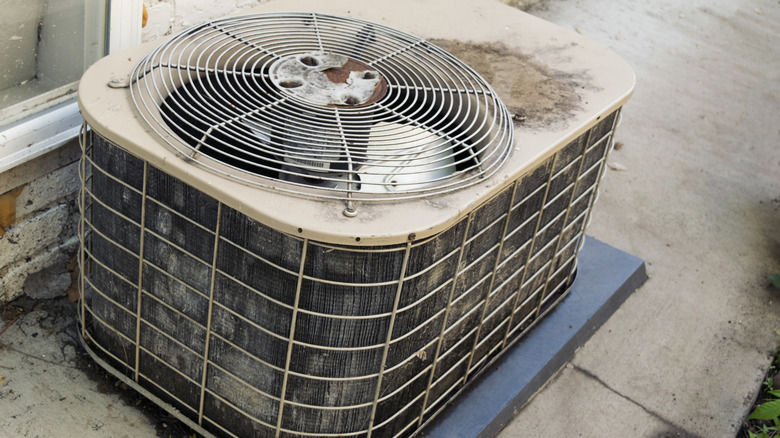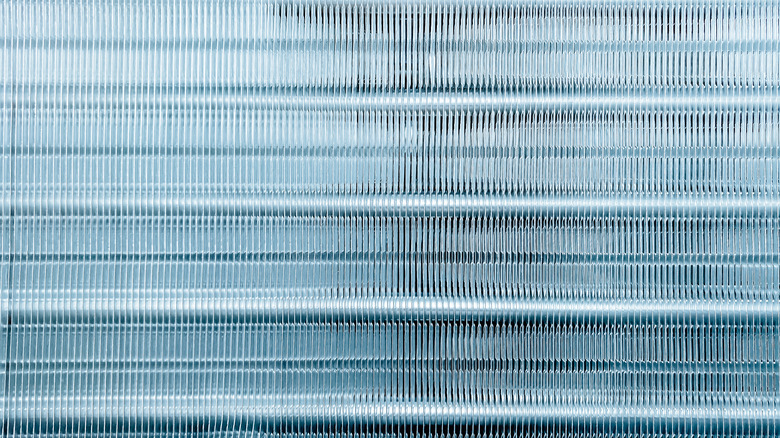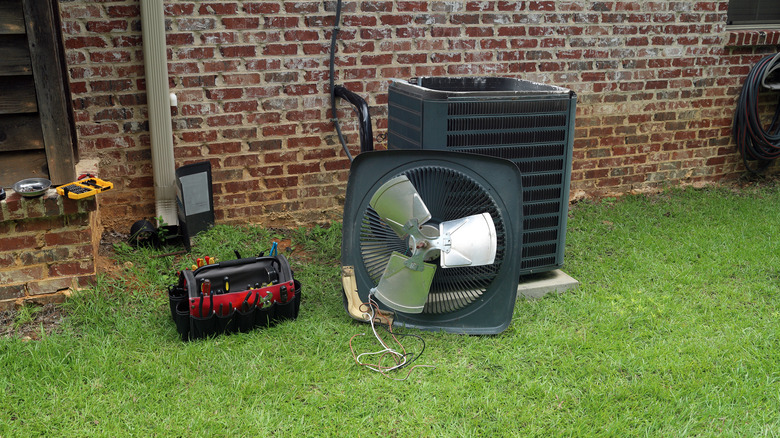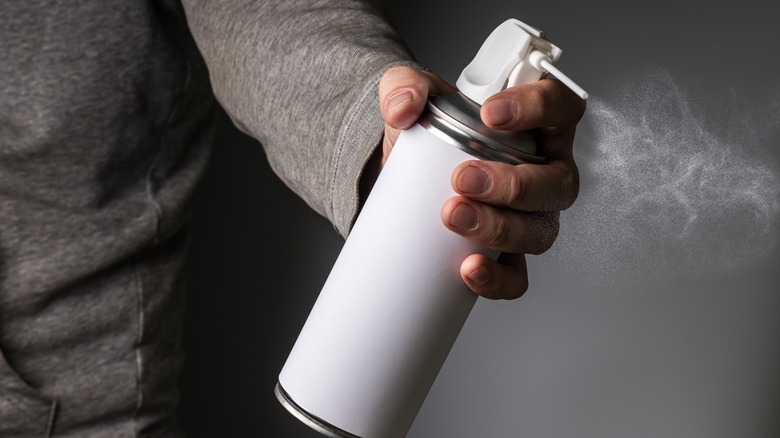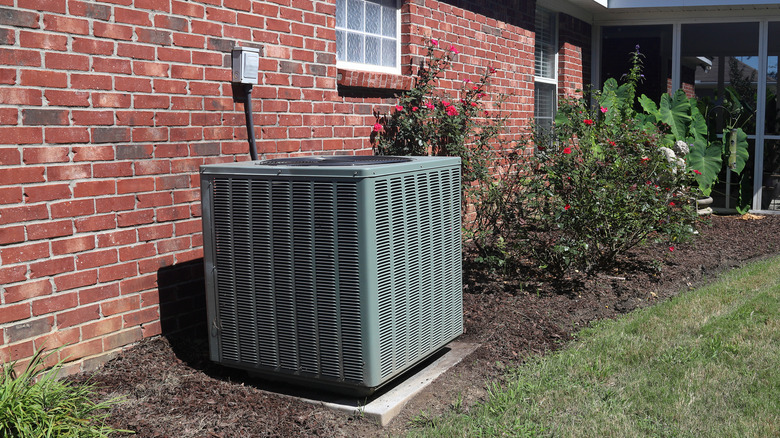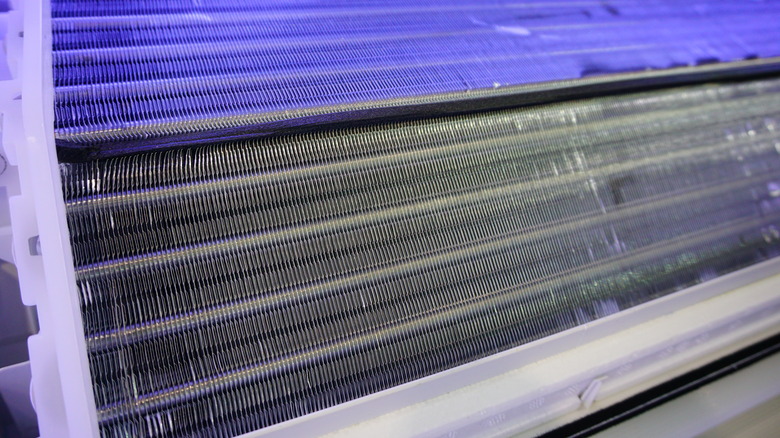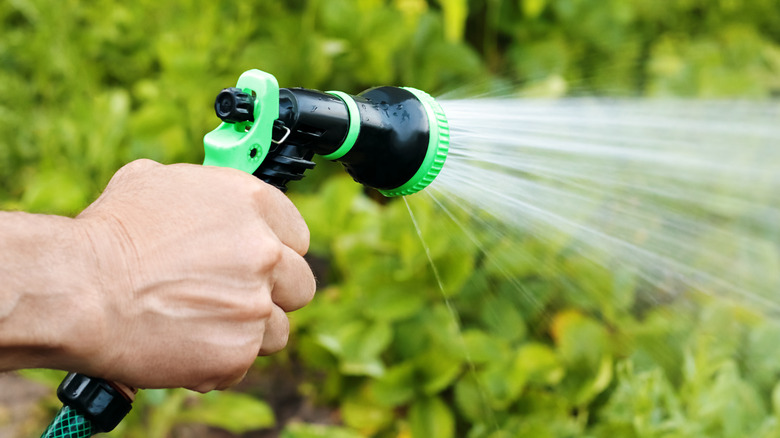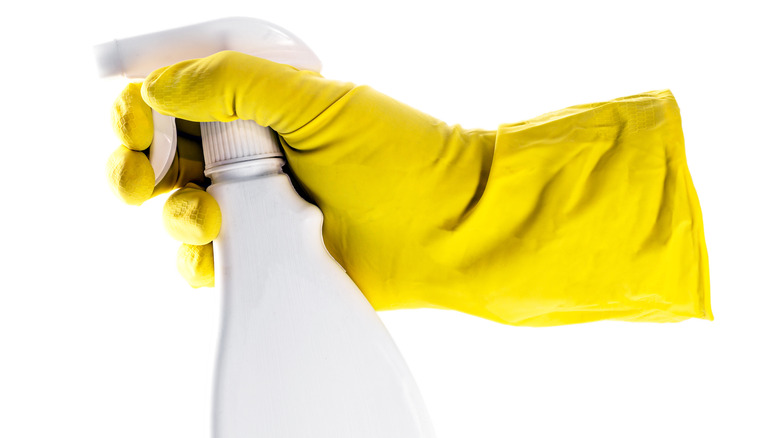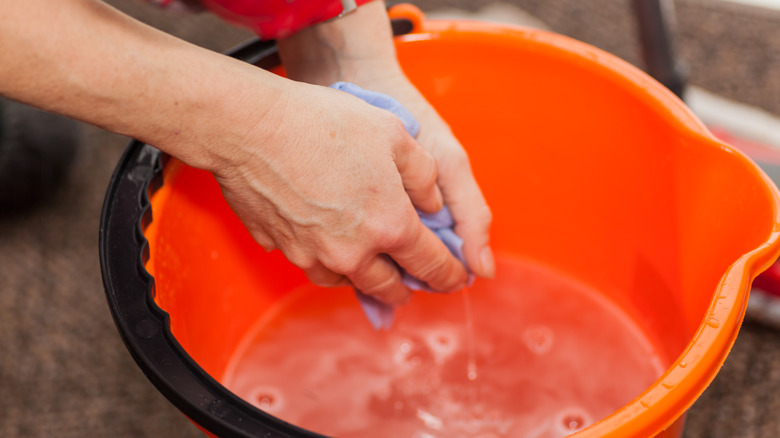How To Clean AC Coils
We may receive a commission on purchases made from links.
Cleaning the AC coils in your HVAC system or window unit is a preventive home maintenance task that can save you money and lead to a healthier indoor environment. Arista notes that cleaning your AC coils is like an "insurance policy" that extends the life of your system. Although you don't see the coils, they work whenever your AC runs. The evaporator coils inside the indoor unit extract heat and humidity from the indoor air. Located in your home's exterior unit, the condenser coils release the heat and moisture to the outdoor atmosphere.
When dirt builds up on the coils, it blocks this transfer process. Interior evaporator coils collect dust, pollen, pet dander, and allergens from the indoor air. Exterior condenser coils may become even dirtier as they are exposed to organic debris from trees and shrubbery, as well as dirt, pollen, and multiple pollutants in the outdoor air. According to Bradbury Brothers Cooling, Heating, Plumbing & Electrical, the job of cleaning AC coils must be approached with care. DIYers should take the time to learn proper methods for cleaning their units. Otherwise, the homeowner may inadvertently damage the coils, causing further problems. With knowledge and caution, you can keep your AC unit in premium condition by cleaning the coils correctly and regularly. Here's how.
Why you should clean your AC coils
How often do you think about the AC coils in your heating, ventilation, and air conditioning (HVAC) system? Probably not very often. However, dirt, debris, and mold can build up on your AC coils, resulting in reduced efficiency and excessive wear and tear on the unit. When dust, dirt, and grime coat your AC coils, several problems occur. First, the system struggles to keep your home cool. Bill Reynolds Heating & Air Conditioning states that even a small amount of dirt buildup on the coils can negatively affect your system's efficiency. If you feel that your AC is not cooling your home sufficiently, it may be the first sign of dirty coils. In addition to an inadequate cooling effect, the air quality in your home may be compromised by dirt and mold on the AC coils.
According to Superior Air, two additional symptoms indicate that you should clean your AC coils. First, the unit may run longer than usual. Your system is built to operate on cycles according to the thermostat setting. When dirty coils reduce the system's efficiency, it works harder to cool the air, and the cycles become longer. This phenomenon results in a drain on your electricity, resulting in higher costs. Secondly, the evaporator coils in your AC may freeze due to a buildup of dirt and grime. When dirt impedes the transfer of heat from the interior air, a buildup of condensation occurs on the coils. Subsequently, the condensed water freezes, and the AC stops working. This situation requires an expensive repair or replacement of the AC system.
When you should clean your AC coils
You should clean both the evaporator and condenser coils in your HVAC system at least once a year. Big Mountain Air notes that more frequent cleaning may be necessary under certain conditions. For example, the coils in older HVAC systems need to be cleaned more often than those in new units. Additionally, coils become dirtier with heavy usage. Therefore, if climate conditions in your area cause your AC to run almost continuously, the coils will need to be cleaned as much as twice a year or quarterly. The location of your outdoor HVAC system is an additional factor that affects the frequency of cleaning. For example, a unit located close to a busy street will be exposed to air pollution, and a unit situated under trees and shrubbery will collect pollen and organic debris.
You should also give them an extra cleaning if you notice certain conditions in your home. Robert B. Payne, Inc. explains that if your electricity bill is increasing or your house feels warmer than usual, you might suspect that dirty coils are preventing your AC from operating at top efficiency. But don't wait until problems start to occur before cleaning the unit. It's a good idea to inspect the AC coils every couple of months.
The difference between evaporator coils and condenser coils
A & G Services states that the coils are a vitally important part of an HVAC system. Your HVAC system operates with two types of coils: the evaporator coils and the condenser coils. These are found in two different locations, and it's important to clean both types of coils. Berkeys Air Conditioning, Plumbing & Electrical explains that the evaporator coils are found inside the indoor HVAC unit. These are copper coils that contain refrigerant, and they have metal fins surrounding them to aid in the heat-conducting process. As air from a blower moves across the evaporator coils, the refrigerant inside the coils extracts heat from the air. As the heat is removed from the room, the air is cooled. Then, the cooled air flows through ducts that carry it throughout the house.
After the evaporator coils extract the heat, it moves to the outdoor HVAC unit, where the condenser coils release the heat into the outdoor atmosphere. This heat transfer process is accomplished via a compressor that heats and pressurizes the refrigerant flowing through a conduit from the indoor to the outdoor unit. As the refrigerant flows through the condenser coils, the heat is released via an exhaust fan blowing through the coils to disperse the heat outdoors.
How to safely access your AC coils
Before you can clean your AC coils, you'll need to access them within your indoor and outdoor HVAC units. Evapco explains the safety precautions that apply to this procedure. First, turn off your HVAC system at the thermostat. Then, turn off the electrical current that flows to the HVAC system. In most cases, this is accomplished by flipping a switch at the circuit breaker panel. Once you've cut the electrical current, you can safely work on cleaning your AC coils.
Your indoor HVAC unit is typically found in a closet, attic, or basement. You'll need to remove the screws, covering, or panel to access the evaporator coils. Inside the unit, the refrigerant-filled evaporator AC coils are configured like a large, capital letter A. Similarly, you'll need to access the condenser coils in your outdoor HVAC unit by removing screws and panels. It's important to exercise caution when cleaning because the soft-metal coils and fins may be easily damaged.
Clean your AC coils with compressed air
You may be familiar with compressed air (sometimes called canned air or aerosol dusters) for cleaning computer keyboards and other small electronics. The same method can be used to clean your AC coils. Blowing compressed air from a can onto the coils is a quick and easy way to remove dry debris and dust. This method is particularly well-suited for the evaporator coils in your indoor HVAC unit. Hold the can several inches away from the coils and fins to avoid damaging them via the pressurized air. Chemtronics advises that canned air is not safely breathable. Therefore, you should ensure plenty of ventilation when you use it to blast dust and dry particles from your evaporator AC coils. Although you should keep doors and windows open for a safely ventilated work area, you may rest assured that canned air (an aerosol product) does not hurt the ozone layer.
Safety + Health Magazine offers guidelines for safety when using compressed air for cleaning. Always point the can away from yourself. Due to the highly flammable nature of the gasses in canned air, you should ensure that the electrical current to your HVAC unit is shut off. Additionally, it's important to hold the can in an upright position. This allows the gas above the liquid in the can to disperse into the air when the nozzle is depressed. Tilting the can result in liquified gas expelling into the air and onto surfaces. This may create a fire hazard.
Clean your AC coils with a brush
You can use a brush with moderately stiff nylon bristles to clean your AC coils. This will only work if they don't have caked-on grime. If you're simply dealing with dust and dry debris, a brush may be the only tool you need. Do not use a metal or wire brush, as it can damage the coils and fins, as per Day & Night Air Conditioning, Furnace, & Plumbing. If you haven't serviced your coils in a while and need to clean them with a solution, you should use a scrubbing brush with soft nylon bristles.
Top 10 Best recommends commercially available tool sets designed for cleaning AC coils. Along with fin combs, these sets provide brushes that resemble small whisk brooms. The manufacturers of the AC coil-cleaning tool sets include Boao, Chengdu, Fiada, Midwest Hearth, Pimoys, and Shuian. The tool sets with brushes are available from Amazon.
Clean your AC coils with a fin comb
A fin comb is a special tool that removes dirt between the tiny, soft-metal fins surrounding the AC coils. The purpose of the fins is to facilitate airflow, making it easier for the evaporator coils to extract heat and humidity from indoor air and for the condenser coils to release heat into the outdoor atmosphere. Nimvo notes that due to the delicate structure of the fins, it is common for them to become bent during the lifetime of an AC unit. Problems arise because the bent fins obstruct the airflow around the coils. Therefore, straightening the fins with a fin comb is a vital part of cleaning both the evaporator and condenser coils in your HVAC system. By running a fin comb lengthwise through the fins, you can straighten them and remove the dirt and debris trapped between the thin pieces of metal.
Fin combs come in a variety of sizes and shapes to suit an array of HVAC systems. Airtro observes that fin combs feature interchangeable heads to adapt to different units. You can match a fin-comb head with the number of fins per linear inch in your home's indoor or outdoor HVAC units. Ensure the electrical current is switched off before using a fin comb. Then, insert the comb between the fins at the bottom and comb upward to remove dust and debris while straightening the soft metal fins. Continue the process, moving through all of the fins in your unit.
Clean your AC coils with a garden hose
When it's time to clean the AC condenser coils in your outdoor HVAC unit, hosing them down with water is an ideal cleaning method. If you've already switched off the electrical current to the HVAC system, it's safe to spray water from a garden hose onto the condenser coils. However, Provincial Heating & Cooling Inc. warns that you should affix plastic wrap securely around the motor and electrical wires to avoid water damage. Although moderate pressure from a garden hose is recommended, the intense water pressure from a power washer may damage the condenser coils and fins. These parts are typically made from copper and aluminum, and those soft metals can bend easily.
After spraying your condenser coils with water, you'll want to use a commercial or homemade cleaner to continue the job. After applying a foam or a detergent mixture, the garden hose comes into play again for rinsing away the residue from the cleaners. After the final rinse, allow all parts of the outdoor HVAC unit to air dry for at least 60 minutes before reattaching the covering panels and restarting the system.
Commercial cleaners for AC coils
If you're wondering what kind of cleaner you need, several products will get the job done. HVAC Guides 101 observes that AC coil cleaners take three forms. These include (1) alkaline cleaners that tackle dirt and grime without damaging the copper and aluminum coils and fins, (2) acidic cleaners that must be used with care, and (3) foaming cleaners that are formulated to cling to the coils without causing damage. Of these three types, the commercially prepared, foaming cleaners are highly recommended.
HVAC Training Shop recommends five commercial cleaners for AC coils. Nu Calgon Evap Foam is a spray-on, foaming cleaner that does not require rinsing. However, optional rinsing is recommended for the detergent-based Frost King Air Conditioner Coil Foam Cleaner. If you're looking for something more manageable, WEB WCOIL 19 Coil cleaner is a detergent-based foam that DIYers can use on both evaporator and condenser coils. Rinsing is recommended. Finally, Comstar Coil Safe professional-grade coil cleaner is recommended for both indoor and outdoor use. Dilute it with water and spray from a separate pump sprayer.
Homemade (DIY) cleaners for AC coils
It's not necessary to purchase a commercial cleaner for your AC coils. You can make your own cleaning solution following these suggestions. Action Air recommends diluting white vinegar with water in a spray bottle and spraying the mixture onto dirty AC coils. White vinegar is an effective natural cleaner due to its acidity level. For greasy or sticky residue on the coils, you may want to add 1 tablespoon of baking soda to the diluted vinegar solution. Alternatively, you can achieve good results by mixing a mild dish detergent with water in a spray bottle and spritzing the coils. Of course, rinsing is recommended.
According to Breathe Better Air, you can mix white vinegar with rubbing alcohol in a 1:1 ratio and then add a small amount of baking soda to create an effective cleaner for mold and mildew in your AC coils. Alternatively, a mixture of water, dish soap, and baking soda makes a slightly abrasive cleaner that removes stubborn, stuck-on dirt from coils. If mold and mildew are a significant problem, you can spray a solution of 1 part bleach and 3 parts water onto the coils. This method should be used with caution, as the smell of bleach might disperse throughout your house via the ventilation system. After using cleaners on your AC coils, follow up by rinsing with clear water.
